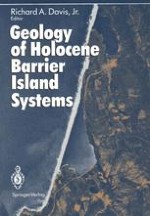1994 | OriginalPaper | Buchkapitel
Texas Barriers
verfasst von : Robert A. Morton
Erschienen in: Geology of Holocene Barrier Island Systems
Verlag: Springer Berlin Heidelberg
Enthalten in: Professional Book Archive
Aktivieren Sie unsere intelligente Suche, um passende Fachinhalte oder Patente zu finden.
Wählen Sie Textabschnitte aus um mit Künstlicher Intelligenz passenden Patente zu finden. powered by
Markieren Sie Textabschnitte, um KI-gestützt weitere passende Inhalte zu finden. powered by
The modern configuration of the Texas coast reflects competition between fluvial-deltaic sedimentation and reworking by marine processes that produce a dominant westerly flow in the northern Gulf of Mexico (LeBlanc and Hodgson 1959). This westerly flow and the regional distribution of barrier islands led some early workers to conclude that Texas barrier islands were deposited by littoral drift reworked from the Mississippi River. More recent geologic studies have shown that Texas barriers are reworked deltaic deposits but of Texas coastal plain rivers rather than the Mississippi. Erosion of relatively stable deltaic headlands, winnowing of the eroded material, and deposition of the coarse fraction in interdeltaic embayments are the result of wave and current dominance over fluvial supply. An important geologic consequence of the disequilibrium in forces is that thickest deposits of well-sorted barrier sand are located the greatest distance from any fluvial source.The principal factor in barrier formation has been both small-scale and large-scale sea-level fluctuations including those produced by (1) daily astronomical tides, (2) storms, and (3) late Wis-consinan glacio-eustatic changes. Lagoons approximately 8 km wide separate the barrier chain from the mainland. The barriers are located at this distance from the mainland because sea level is slightly lower than the coastal plain, which formed during the Sangamonian highstand in sea level.Barrier islands compose about 80% of the Texas Gulf coast. The remaining coastline is composed of mainland beaches that front two Holocene deltas and a Pleistocene promontory.All three of these headlands are composed of stiff deltaic mud. Of the sandy barrier segments, about 45% are retrogradational, 35% are pro-gradational, and 20% are aggradational.Barrier island age, morphology, geographic position, and storm response are controlled by the evolutionary history of the coast. Retrogradational barriers are narrow, thin, and have low topographic profiles that allow repeated over-wash by even minor storm surges. These relatively young migrating barriers are located on the flanks of eroding deltaic headlands. In contrast, pro-gradational and aggradational barriers are wide, thick, and have high topographic profiles that effectively prevent storm surges from washing over the islands. These relatively old barriers formed at the nodes of the interdeltaic bights where sand supply was concentrated. Transitional barriers separate retrogradational barriers from the other two types of barriers. They are similar to retrogradational barriers in that they have low profiles but washover does not completely transect the barrier core. Therefore, the back-barrier margins of transitional barriers are not prograding into adjacent lagoons and these islands are not retreating landward.Since the Holocene transgression, delineation of modern barriers in Texas has been controlled by the low tide range and climatic gradient. The lateral limits of upper and middle coast barriers are well defined and they are separated by widely spaced tidal inlets. Nearly all these barriers are more than 50 km long and there is only one barrier and one tidal inlet for each bay system. The primary river entering each upper and middle coast bay, the axis of the associated entrenched valley, and the tidal inlet are commonly either aligned or in close proximity to each other. In contrast, the south Texas coast is composed of a single barrier about 160 km long. Tidal inlets are absent from this coastal segment because of low freshwater inflow, high evapotranspiration, and predominant eolian processes that are related to a semiarid climate.Texas barriers are entering a new phase of their evolution as a result of recent increases in the rate of relative sea-level rise and decreases in sediment supply. Retrogradational barriers are continuing to migrate landward while most of the other barriers are getting narrower. This is because of simultaneous erosion along both Gulf and lagoon shores. An exception to this trend is Central Padre Island, which remains an actively aggrading barrier. Sand released by updrift beach erosion is transported to this barrier segment by converging littoral currents. The sand supplied to the Central Padre beaches, dunes, and back-barrier environments (wind-tidal flats) is sufficient to maintain a stable landform even as relative sea leyel is rising.
